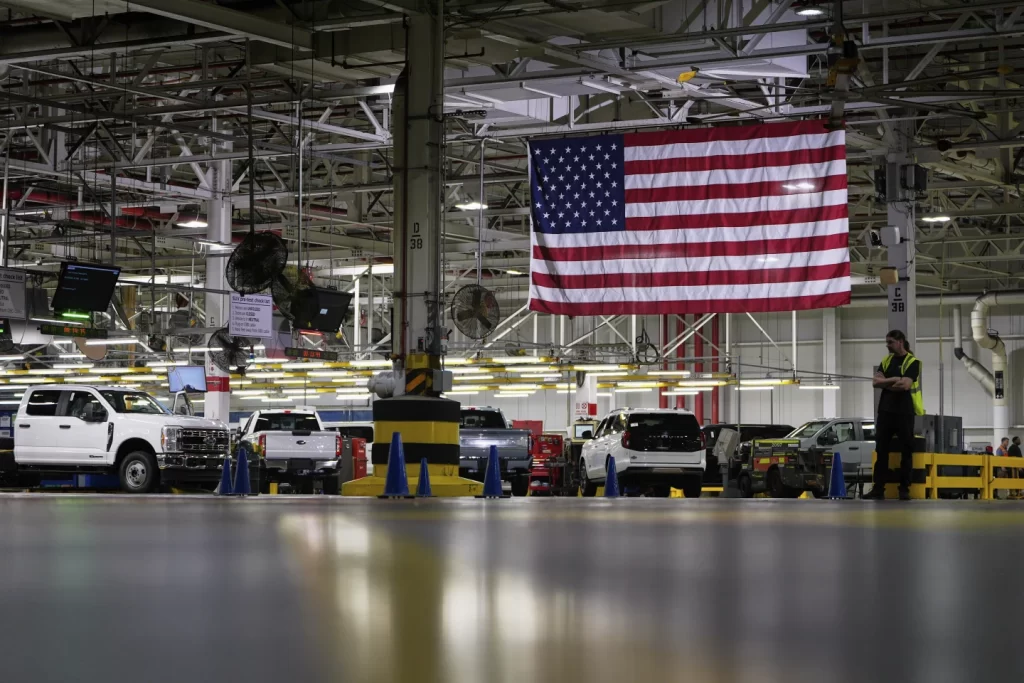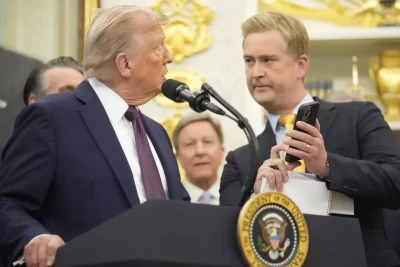
WASHINGTON— Michigan Gov. Gretchen Whitmer met privately in the Oval Office with President Donald Trump to make a case he did not want to hear: the automotive industry he said he wants to save were being hurt by his tariffs.
The Democrat came with a slide deck to make her points in a visual presentation. Just getting the meeting Tuesday with the Republican president was an achievement for someone viewed as a contender for her party’s White House nomination in 2028.
Whitmer’s strategy for dealing with Trump highlights the conundrum for her and other Democratic leaders as they try to protect the interests of their states while voicing their opposition to his agenda. It’s a dynamic that Whitmer has navigated much differently from many other Democratic governors.
The fact that Whitmer had “an opening to make direct appeals” in private to Trump was unique in this political moment, said Matt Grossman, a Michigan State University politics professor.
It was her third meeting with Trump at the White House since he took office in January. This one, however, was far less public than the time in April when Whitmer was unwittingly part of an impromptu news conference that embarrassed her so much she covered her face with a folder.
On Tuesday, she told the president that the economic damage from the tariffs could be severe in Michigan, a state that helped deliver him the White House in 2024. Whitmer also brought up federal support for recovery efforts after an ice storm and sought to delay changes to Medicaid.
Trump offered no specific commitments, according to people familiar with the private conversation who were not authorized to discuss it publicly and spoke only on condition of anonymity to describe it.
Whitmer is hardly the only one sounding the warning of the potentially damaging consequences, including factory job losses, lower profits and coming price increases, of the import taxes that Trump has said will be the economic salvation for American manufacturing.
White House spokesman Kush Desai said no other president “has taken a greater interest in restoring American auto industry dominance than President Trump.” Trade frameworks negotiated by the administration would open up the Japanese, Korean and European markets for vehicles made on assembly lines in Michigan, Desai said.
But the outreach Trump has preferred tends to be splashy presentations by tech CEOs. In the Oval Office on Wednesday, Apple CEO Tim Cook gave the president a customized glass plaque with a gold base as Cook promised $600 billion in investments. Trump claims to have brought in $17 trillion in investment commitments, although none of those numbers has surfaced yet in economic data.
Under his series of executive orders and trade frameworks, U.S. automakers face import taxes of 50% on steel and aluminum, 30% on parts from China and a top rate of 25% on goods from Canada and Mexico not covered under an existing 2020 trade agreement. That puts America’s automakers and parts suppliers at a disadvantage against German, Japanese and South Korean vehicles that only face a 15% import tax negotiated by Trump last month.
On top of that, Trump this past week threatened a 100% tariff on computer chips, which are an integral part of cars and trucks, though he would exclude companies that produce chips domestically from the tax.
Whitmer’s two earlier meetings with Trump resulted in gains for Michigan. But the tariffs represent a significantly broader request of a president who has imposed them even more aggressively in the face of criticism.
Materials in the presentation brought by Whitmer to the meeting and obtained by The Associated Press noted how trade with Canada and Mexico has driven $23.2 billion in investment to Michigan since 2020.
General Motors, Ford, and Stellantis operate 50 factories across the state, while more than 4,000 facilities support the auto parts supply chain. Altogether, the sector supports nearly 600,000 manufacturing jobs, forming the backbone of Michigan’s economy.




